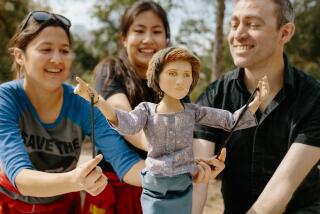Storytellers Entrance Young, Old : Indonesian Puppets Teach Life in Shadows
- Share via
JAKARTA, Indonesia — Round about midnight, three hours into the performance, the beat of drums and gongs signals a battle scene of the great epic.
Shadows on a screen of cloth, the protagonists whirl and tumble amid the clangor. This time the virtuous triumph and the audience whoops approval. Another lesson has been learned.
In these final weeks of the dry monsoon, in the villages of central Java and others across the Indonesian archipelago, the wayang --the shadow-puppet play--reaches a seasonal high point, continuing a tradition of storytelling perhaps 1,000 years old. It is a campfire tale, a grand opera and a visual investigation into the mystical world of men, gods and self. The wayang binds Indonesians to their culture, a medium with a message.
From village child to lofty professionals, each viewer draws some special significance from the stories and the characters.
Physicist Explores Meaning
In a recent lecture here, M.S.A. Sasttroamidjojo, a physicist who heads Indonesia’s solar energy research center, argued that the depth of meaning in the wayang could correspond to the scientific theory that there is no ultimate subnuclear particle. The puppet itself, he said, is crafted as a solid shadow so that what appears on the screen is “the shadow of a shadow” manipulated by a puppeteer who himself is a puppet in the hands of a higher order. The Javanese, even physicists, take a back seat to no one when it comes to the mysteries of life.
Espousing a less complex explanation was Bambang Gunardjo, director of Jakarta’s wayang museum, who said simply: “The importance of the wayang is not only in its entertainment, but in its philosophy.
“There comes a time when a boy has to find out who he is. He finds the answer in the wayang. He finds what it means to be a Javanese.”
What began and remains a fixture in the Indonesian countryside has spanned the centuries largely unchanged, though performances can now be enjoyed via videocassette and, with a little imagination, even over radio. In any medium, the message is delivered by the dalang , a man, Gunardjo says, “with the IQ of a professor, . . . very difficult, extraordinary people.”
Seen as Medium to Spirits
The dalang is the storyteller, puppeteer, orchestrator, improviser and, some Javanese believe, a medium to the spirit world. The best are also very big box office, demanding nearly $2,000 a performance.
Most conduct the wayang kulit, a form of the play that uses two-dimensional puppets made from the leather of water buffalo. More rarely seen are the wayang golek , which features a three-dimensional wooden puppet, and the flat wooden puppet of the wayang klitik .
All wayangs are performed behind a back-lit cloth screen, on which the shadowy figures move into focus in the nimble hands of the dalang . But today, more often than not, the light is an electric bulb, which lacks the mysterious flickering quality of the oil lamps used in years past. And many in the audience now watch from behind the screen, where they can see the handiwork of the dalang and the musicians, and the bright colors of the two-foot-high, painted puppets.
The late President Sukarno, who led Indonesia to independence, liked to watch the dalang at work, and it was he who popularized the move from the shadow side of the screen to the backstage sets, Gunardjo said.
Performs Until 5 A.M.
The skills demanded of an accomplished dalang are formidable. He performs without stop from 9 o’clock at night, the traditional curtain time for a wayang , until about 5 a.m. the next day. His repertoire may include 150 stories, and for each he handles and speaks for 30 to 40 puppet characters.
Edward C. Van Ness and Shita Prawirohardjo wrote in their study of the wayang kulit :
“(The dalang ) must be able to portray each of the characters in the story precisely according to their personality, using specific voice techniques and pitch levels. He must be a master of the many movement techniques of shadow puppetry in relation to scene and context, all of which are highly conventional.”
He also cues the band, a gamelan orchestra of traditional gongs, drums and stringed and xylophone-like instruments, some of which he sometimes plays himself.
Physically Extraordinary
The dalang’s performance is physically extraordinary. Seated cross-legged on a mat directly behind the screen, and backed by the orchestra, he manipulates the puppets by means of a central stick attached to the body and two others connected to the hands. The puppets’ arms are hinged at the shoulder and the elbow.
Beside him sits the traveling box for his puppets, and hanging from the box are two or more metal plates which the dalang will occasionally bang to cue the orchestra--with a wooden mallet held between the toes of his right foot. At other times he bangs the inside of the box with another mallet held in his left hand.
All this is just routine for the big-league dalang. In Javan society, where form in all endeavors tends to the orthodox, the dalang is known not only for his mastery of tradition but for his improvisational techniques.
Touch on Contemporary Issues
There is, for instance, a moment in the repertoire that is more or less free-form. That is the appearance of the clown characters during stories of the “Mahabarata,” a Hindu epic. In the hands of a master dalang , the clowns may wander into contemporary issues, said Gunardjo, the museum director:
“A few years ago, there were some farmers whose property was being bought by the government for the construction of a dam. They were to be moved to another area, but they didn’t think they were getting a fair price for their land.
“Well, they heard the governor was coming to the wayang that night and they asked the help of the dalang. When the clowns appeared, they made some oblique references to the problem. The governor got the message, and everything was OK in a couple of weeks.”
Normally, the message of the wayang is not so specific, but it is instructive nonetheless. Most of the stories derive from two great Hindu epics, the “Mahabarata” and the “Ramayana,” brought to these islands by traders from the Indian subcontinent nearly 2,000 years ago. Their influence has been no less than the biblical and Homeric stories in the West.
The “Ramayana” cycle, popular throughout Southeast Asia, centers on a relatively straightforward story. The hero, Rama, an almost painfully virtuous prince and the incarnation of the Hindu God Vishnu, is banished to the forest where he lives with his wife and his brother. The wife is abducted by an ogre king. With the help of an army of monkeys, the king is overcome and killed. Good triumphs over evil, and the lesson is clear.
Characters More Complex
The “Mahabarata” is more intriguing to the Javanese, because the characters are more complex. It is the story of two sets of cousins competing for a throne. Unlike Rama, the heroes of the “Mahabarata” have flaws.
Arjuna, a leader of the good guys, is a compulsive lady-killer with a fanatical sense of duty. His brother, Bima, is aggressive and coarse, speaking in vulgar language even to the gods. In battle scenes, he does in his foes with a huge, thorny fingernail.
But Arjuna and Bima are blessed with what the Javanese call alus --a refined manner, ultimately polite and humble. The gruff Bima qualifies on the grounds of his intrinsic kindness and adherence to principle. The lesson is to strive to be alus , not kasar , the term for crass or graceless behavior.
In the same way, the continued popularity of the wayang in a developing country, even in the big metropolis of Jakarta, indicates a resistance to encroaching Western ways in Asia.
Hurt by High Costs
The high costs of a performance, even with an estimated 40,000 dalangs , including some highly regarded female storytellers, has become a hindrance to the art, however. The royal courts were the great sponsors of wayang , but their time is passing.
The government often uses the wayang , with modern characters, to teach new messages--birth control, for instance. And Christian missionaries have adopted the form to spread the Gospel.
But the weekly brief performances of the wayang at Gunardjo’s museum have been temporarily discontinued.
“It’s a matter of money,” he said. The museum is using video renditions instead.
Still, in the countryside, tradition has changed little since the museum director was a boy in the 1940s.
“In Java, a boy heard the stories of the wayang at bedtime,” Gunardjo recalled. “And nearly every Saturday night there was some occasion to be celebrated with a wayang in the village--a birth, a wedding, a festival for the rice planting.”
More to Read
The biggest entertainment stories
Get our big stories about Hollywood, film, television, music, arts, culture and more right in your inbox as soon as they publish.
You may occasionally receive promotional content from the Los Angeles Times.










